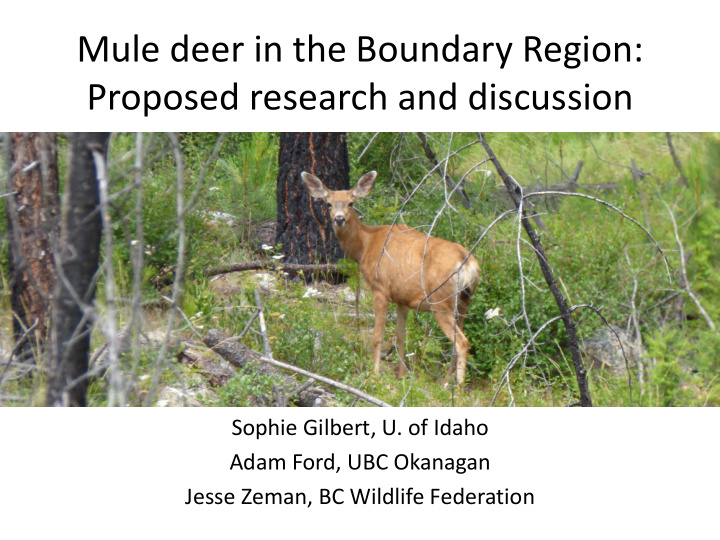



Mule deer in the Boundary Region: Proposed research and discussion Sophie Gilbert, U. of Idaho Adam Ford, UBC Okanagan Jesse Zeman, BC Wildlife Federation
The Boundary Deer Herd • “… (it is) difficult to cast the mind to those earlier days when deer roamed through the foothills in bands of thirty or forty” (Martin Burrill, Grand Forks Gazette, Dec 23, 1905) • 1914 first Fish and Game Protective Association Formed • Concern of over-harvest related to mule deer led to Spalding report (1968) • “The Boundary must be considered as one of the best mule deer and whitetail deer areas of the Province”
History • Large fires 1908 and 1930s • “Very good hunting in 1930s, hunters couldspot their game from the Cochrane ranch. Nowadays, this same sidehill is so thichly over-grown with second-growth fir and pine that game cannot beseen from the bottom of the valley.” (Spalding, 1968) • Successive changes in regulations from no regulations; 4 deer; 100+ day buck, 20 day antlerless; draw for antlerless; 60 day 4 pts or better
Boundary MD Harvest 40 yrs of Reg Changes 1966-67 2011 Buck Antlerless Total Buck Antlerless Total 1755 1170 2925 660 75 735
Mule deer declined across the west for several decades, including in BC
But recently, many herds have increased or stabilized:
But recently, many herds have increased or stabilized:
Advances in mule deer research:
Bottom-up: nutrition pathway Predation – + Nutrition
Nutrition: affects survival and reproduction
Improving nutrition Increased survival and pop growth Bishop et al. 2009
Removing predators No change in survival or pop growth Hurley et al. 2011
The rise of the white-tail: A mule deer competitor?
Top down: Predation pathway – – Predation + Predation Nutrition
Bottom up: Compete for nutrition – + + Nutrition
Our proposed research: How do mule deer in the Boundary respond to landscape change?
Forest loss (2000-2014) A dynamic, mosaic of regeneration Forest gain (2000-2012)
Areas within 500m of access
Urbanization; Tree encroachment
Heyerdahl et al . 2012
Heyerdahl et al . 2012
Burned Unburned
2015 2014 Rock Creek Fire
Proposed research focus: 1. Identify key drivers of mule deer population dynamics in the Boundary Region 1. Focus on how landscape change affects nutrition and survival of females and fawns.
Proposed research questions: 1. How does deer nutrition on the landscape change following disturbance (fire and timber harvest)?
Proposed research questions: 2. How does deer habitat selection, exposure to predators, and seasonal migration of deer change following disturbance?
Proposed research questions: 3. What are the effects of disturbance on deer survival, reproduction, and population growth?
Proposed research questions: 4. How does disturbance affect mule deer mortality from starvation, disease, predation, and hunting mortality?
Proposed research questions: 5. How does weather interact with disturbance to affect deer?
Approach: A. Capture & monitor adult female deer (~90) and fawns (~150) deer. - Fit adult female with GPS collars - Fit fawns at birth with VHF radio collars Need for volunteers in monitoring for birth/death events
Approach: B. Measure deer nutrition in different habitat types This info will be used to make a mule-deer “food map.” Need for volunteers in measuring veg
Approach: C. Use remote cameras to measure: - Relative abundance of muleys, white- tails, and predators - Group composition (doe:fawn ratios) Need for volunteers in deploying and checking cameras
Approach: D. Collect detailed weather data, including: - Temperature - snow depth Need for volunteers in winter weather monitoring
Approach: E. Using all this information (A-E), plus satellite imagery, model optimal landscape configurations that meet both forestry and wildlife objectives under different wildfire scenarios
Collaborators, Funders, Partners • BC Wildlife Federation • Okanagan Nation Alliance • Government • Okanagan Region BC • Granby Guides & Wildlife Federation Outfitters • The Wildlife • Grand Forks Wildlife Stewardship Council Association • University of British • Habitat Conservation Columbia Trust Foundation • University of Idaho • Industry
Discussion: 1. What do you think drives the mule deer in the Boundary region? 2. How can we improve this project’s design?
Recommend
More recommend